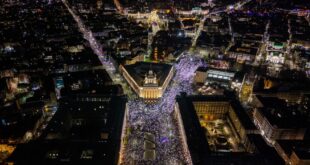 On June 1 2007 the Moscow Prosecutor’s Office suspended the official inquiry into the “terrorist” attack on the Dubrovka theatre complex, during which Chechen guerrillas took hostage more than 900 spectators of the show “Nord-Ost”.According to the materials of the inquiry, five of the hostages were killed directly by the “terrorists”, while at least 125 more died in the course of special operations to secure their release. Russian justice has fulfilled the task that was entrusted to it by the authorities: there has been no trial of those responsible for the deaths of those people. The “terrorists” were declared “destroyed” (with the exception of two, whose whereabouts “have not been established”).
On June 1 2007 the Moscow Prosecutor’s Office suspended the official inquiry into the “terrorist” attack on the Dubrovka theatre complex, during which Chechen guerrillas took hostage more than 900 spectators of the show “Nord-Ost”.According to the materials of the inquiry, five of the hostages were killed directly by the “terrorists”, while at least 125 more died in the course of special operations to secure their release. Russian justice has fulfilled the task that was entrusted to it by the authorities: there has been no trial of those responsible for the deaths of those people. The “terrorists” were declared “destroyed” (with the exception of two, whose whereabouts “have not been established”).
As for the question of medical assistance to the injured hostages, the investigation says that such assistance was provided in a professionally qualified and timely manner. The massive loss of life that occurred during the hostages’ release was not directly related to the use of a gas “whose nature has not been established by the inquiry”, but was due to “a combination of exceptionally unfavourable factors” (chronic illness, lack of food, dehydration, stress, and so on).
It should be borne in mind that this is the explanation supplied by the official inquiry. However, a large amount of evidence points to a conflicting version of events.
Was the gas responsible for the deaths?
Several points of view have been expressed regarding the degree of danger to the hostages posed by the gas that was used.
Thus, Professor B.M. Blokhin (Dr. med.) considers (28.9.) that the cause of death was not the toxicity of the gas, but rather an absence of the correct conditions for the transportation of the victims. The gas acted on many of the hostages like a general anaesthetic during an operation. In the situation that developed, the victims needed artificial ventilation of their lungs and the adoption of measures to prevent them swallowing their tongues (which would choke them in their unconscious state). During the evacuation of the hostages these conditions were not made available. It is also worth noting that the gas was released into the auditorium at around 5.30am, but the mass evacuation of the victims did not begin until one and a half hours later. To this must be added the time it took to get them to hospital in conditions of general confusion. The inevitable result was that a large number of hostages died even before the storming of the theatre began, something that is indirectly confirmed by the results of the official inquiry: according to it, the deaths of 114 people were certified at the scene of the incident.
The journalist Andrei Soldatov (Agentura.Ru) also believes that the use of the gas was a knowingly dangerous adventure in which the lives of the hostages were deliberately excluded from consideration. According to his data, which cites personal sources, the effects of the gas can only be neutralized by the injection of an antidote, an obviously unrealistic procedure given the huge number of victims over a short period of time.
But the true situation may perhaps have been even worse. Dmitry Milovidov, a member of the coordinating council of the “Nord-Ost” victims’ organization (he is the father of 14-year-old N. Milovidova, who died in the attack) said in a program broadcast by the Ekho Moskvy radio station (“Looking for the exit”) that the gas used at the theatre centre was one that has no antidote. On this he received the indirect support of another participant in the program, Anatoly Yermolin (retired FSB lieutenant colonel and former head of the operations team of the Vympel task force), actually said the following: “‘Nord-Ost’ showed us… that this gas cannot be used – that is the first conclusion I think we must draw.”
It may be objected that most of the hostages (and even a few of the spetsnaz officers) who ended up in hospital after the “gas attack”, none the less survived. Does this mean that the gas was not so deadly after all? We should not forget, however, that the concentration of chemical substance in the auditorium was of varying intensity. Some of the hostages who had managed to get their bearings in the situation breathed through water-soaked garments, which also reduced the degree of toxicity. At the same time, those sitting in the first row received the highest degree of poisoning, but were evacuated last. It was probably among them that the largest number of deaths occurred.
Did the gas save anyone?
Nevertheless, supporters of the official version of what happened claim that the use of the gas saved a large number of the hostages and prevented the “terrorists” from blowing up the building in which they were located. But this assertion does not stand up to criticism.
The gas employed was visible, and its effect was far from instantaneous. This is borne out by the testimony both of the hostages themselves and of the spetsnaz officers who took part in the storming of the theatre complex. Even according to the official investigation, some of the guerrillas continued to hold out for some 10-20 minutes, firing from 13 sub-machine guns and 8 pistols. Moreover, this took place not only in the foyer (which the gas did not enter) but also in the auditorium itself.
That the threat to blow up the building was a very real one is borne out in particular by an interview with one of the men who took part in the storming of the theatre, Sergei Shavrin (who at the time of the events was commander of one of the assault teams):
– At headquarters level the prediction was that there would be losses, there would be dead and injured, there would be shooting, there would be an explosion, there would be a lot of casualties. But what actually happened? The storming was over, there was no explosion, and 800 or more people had to be resuscitated from the effects of the gas. It turned out that no one was prepared for this.
– So an explosion was expected?
– Yes. There were an awful lot of “terrorists”. One of them could have set off an explosive device.
– Then why did none of the “terrorists” blow themselves up? The effect of the gas wasn’t instantaneous, after all.
– When we entered the auditorium, we saw a shakhidka (female suicide bomber). She was sitting on a chair. Her eyes were open, she was holding the electrodes, all she had to do was connect them. Why she didn’t do that is unclear. Perhaps she was waiting for some instruction or command. She had enough time…
– If there had been an explosion, how many people would have survived?
– Less than 10%. But everyone knew that there was another possible scenario: that the “terrorists” would let the spetsnaz into the auditorium, and then someone would blow it up from outside by means of a radio signal. Then it would all be over.
There was no explosion, either from outside or inside. Indeed, the female “terrorists” behaved very strangely. Instead of carrying out their threat and killing themselves along with the hostages, they “made no attempt to blow themselves up, but covered their faces with headscarves and lay down on the floor among the hostages. For about 10 minutes they all lost consciousness.” (see)
The question of why the “terrorists” did not commit suicide still remains open. The official inquiry has been unable to give an convincing answer to it. On the basis of the data available to me at this time, I am forced to conclude that an explosion was technically impossible.
Even before the theatre was stormed, an expert from Kommersant-Vlast magazine, a former KGB officer, examined the NTV footage of the guerrillas seizing the building and drew attention to one particular detail: the “suicide women” blatantly played with the wires of their devices in front of the television cameras, connecting and disconnecting the electrodes on their suicide belts. The retired officer concluded that the belts were probably not fully armed, that it was possible no batteries or detonators had been inserted into them (issue of 10.11. 02; quoted in Viktor Stepakov’s book The Battle for Nord-Ost). This theory was later confirmed, from more than one source. After the storming the journalist Andrei Soldatov wrote:
“According to our information, only two of the women actually had real explosives in their belts. Though it’s possible that even they were empty …
Furthermore, it was determined that the bomb made from an iron cylinder containing 20 kilograms of plastic explosive was also not in working condition at the time of the assault on the building. The wire of its detonator led to the balcony. But there were no “terrorists” there during the assault – they were regrouping in the foyer.”
Similar information was contained in an anonymous letter addressed to the editor-in-chief of the newspaper Versiya:
“I am a prosecutorial investigator who worked at Dubrovka during the “terrorist” attack. I would like to reply to some of the questions you raised in issue 45 (November 18-24) …
With regard to the explosives: not all the explosives were operational. Most of them were dummies, and although the one that the women were wearing was operational, it wasn’t in working order. What’s more, all of this was known to headquarters, as audio and video of the guerrillas was coming through from surveillance devices right from the very first day. And another thing – Russian passports with return tickets were found on the bodies of the dead guerrillas, and this too was known before the assault on the building.”
Information on the use by “terrorists” of dummy explosive devices is confirmed in the book Brides of Allah by journalist Yuliya Yuzik, who cites an anonymous FSB lieutenant and lieutenant colonel in this connection.
The authorities have reacted rather nervously to attempts by others to make an independent inquiry. Andrei Soldatov and other Versiya journalists have repeatedly been hauled in for questioning by the FSB. Yuliya Yuzik was expelled from Chechnya with the threat that she would disappear without trace if she returned to the republic. Her book Brides of Allah was rather quickly banned for sale in Russia. (Incidentally, those who wish to can talk to the journalist in person on her Internet blog).
An impartial investigation into the Dubrovka “terrorist” attack and the massive loss of life that occurred during the hostages’ release is not in the interests of a large number of Russian officials, including some at the highest levels of government. However, former hostages and relatives of those who died have not given up hope of compelling the Russian officials who were responsible for what happened to testify before the European Court of Human Rights in Strasbourg.
Source: Prague Watchdog
 Eurasia Press & News
Eurasia Press & News

